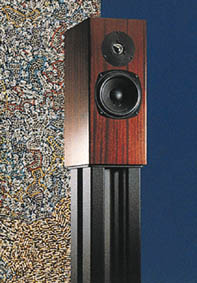 |


TechnoFILE is copyright and a registered trademark © ® of
Pandemonium Productions.
All rights reserved.
E-mail us Here!

Speakers: Big, Small, or hung from the wall?By Jim Bray Part Two: The Components We Used Part Four: Buying a Projection TV Part Seven: Buying Speakers Part Eight: More on Buying Speakers While the quality of your home theater's sound is affected by your amplifier and the source material, it's the loudspeakers that actually take the electrical energy zipping through the wires and convert it into sound waves. So spend some time listening to a few models before plunking down your after-tax disposable income. If you live in a broom closet, coffin-sized speakers are definitely out. That said, however, the opposite doesn't necessarily hold true; you can fill a big room with small speakers if they and their amplification are up to snuff. Dollars spent doesn’t necessarily translate into sound quality, either. While I’ve heard some spectacular speaker systems that cost in the tens of thousands of dollars, I’ve also been amazed at the sound quality I’ve been able to get from fairly inexpensive speakers, if they’re well-designed and built. The most common speakers look like boxes. These can be floor standing, “stand sitting,” or mounted on a wall with brackets. The smaller the speaker, generally, the more "bass challenged" it can be, since it takes a certain amount of air movement to create the long wavelengths of the lower frequencies. That said, I’ve also heard small speakers that put out a surprising amount of bass, though most are more suited to playing back music than they are meant for playing movie soundtracks. This is why subwoofers are so popular now: they can add extra oomph to a small pair of speakers, and that can make the difference between an explosion sounding like a muffled poot or shaking your very foundations. Multi-piece systems, which use tiny "satellite" speakers to handle the high and midrange frequencies and a subwoofer for the bass, have also become increasingly popular in recent years. An advantage to this setup is that the satellites can be mounted, or placed, just about anywhere (within reason, of course - you don't want them in a closet!), from wall brackets to wall units, while the subwoofer (which isn't nearly as sensitive to where it's physically located in the room) can be hidden in a corner or behind the sofa. This leaves you with more room for furniture! For a typical surround sound home theater system, you'll need several speakers. The left and right speakers of the traditional stereo audio system will double as your main front speakers. You’ll also need a center speaker (which should be magnetically shielded so it won’t cause colored splotches on your TV) and at least one pair of surround speakers. A subwoofer is optional but, as mentioned above, highly recommended to ensure that, when the big spaceships come on screen at the opening of the "Star Wars" films, your home theater is moved by the proper “Phantom” Menace. Of all these speakers, the two main (front) ones are the most important, as this is where the lion's share of the full range of sound originates, especially when you’re playing music (and movies have music too, remember). Next in importance is the center channel, because that's where most of the dialogue originates. You can get away without a separate center channel (using what they call "phantom" mode), but it isn't nearly as satisfying. Surround speakers are used mostly for effects and you can get away with a smaller, less expensive pair if necessary. This is only a rule of thumb, though, and purists will argue you need to pay as much attention to your rear (speakers, that is) as to the rest. The THX police won’t break down your door to check up on you, however, so make up your own mind. Speakers should be invisible. That is, they shouldn’t add or subtract sound. This is great in theory, of course, but the dickens to get. In the real world, what you'll end up doing is buying a speaker that "colors" the sound in a way your ears find the most acceptable. The most important rule of thumb is "Trust Your Own Ears." When you’ve decided on two or three speakers you like, try to audition them in your home to hear how they sound in their “natural environment.” You’ll probably have to leave a deposit with the store, but that’s okay. Remember to take a familiar CD to the store, too! I’ll outline other considerations, like power, impedance, and placement, in an upcoming column. Jim Bray's technology columns are distributed by the TechnoFILE and Mochila Syndicates. Copyright Jim Bray.
|
|
|
| Support TechnoFile via Paypal |
| TechnoFILE's
E-letter We're pleased to offer our FREE private, subscription-based private E-mail service. It's the "no brainer" way to keep informed. Our Privacy Policy |